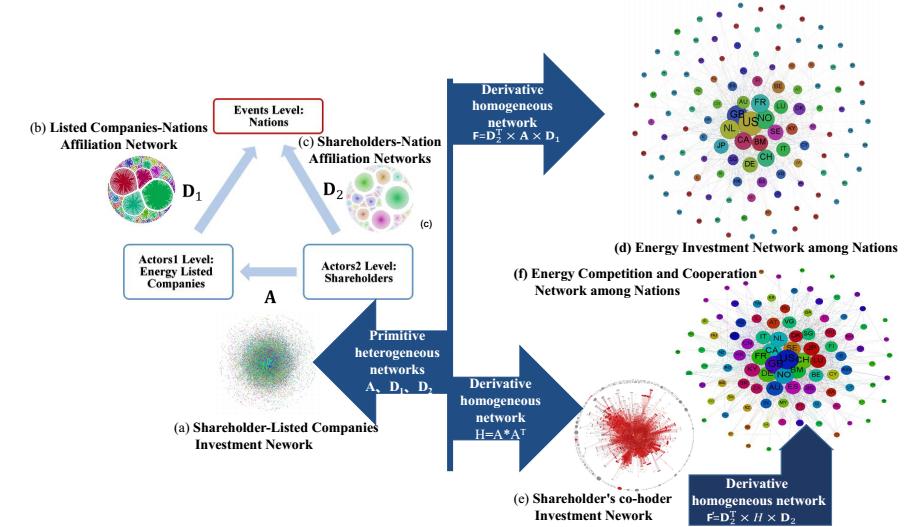| Biography | |
|---|---|
 Dr. Huajiao Li China University of Geosciences,Beijing,China |
|
| Title: Structure of Global Energy Investment, Competition and Cooperation from Shareholding Perspective: Based on a Heterogeneous Complex Networks Model | |
| Abstract: Along with the development of the energy financial market and the increase of energy financial attribute, the global energy financial structure of investment relations[1] as well as the competition and cooperation relations[2] has become a new research perspective. As a complex system with multi objects and multi relations, energy financial market has heterogeneous features[3]. How to choose some representative objects and relations to construct the primitive heterogeneous network model, and analyze the investment, competition and cooperation structure based on the designed derivative algorithms has been a new research focus and challenging topic. By the empirical data of energy stock market, this paper constructed the heterogeneous network model based on three sets of objects (energy listed companies, shareholders, nations and regions (nations for short)) and two types of relations (investment relations[4], national affiliation relations), then, the investment relations of nations[1] were get based on the investment relations between shareholders and listed companies as well as their national affiliation relations, and the competition and cooperation relations of nations[2] were get based on the derivative competition and cooperation relations of shareholders by co-holding behavior[5] and their national affiliation relations (See Figure 1).
Fig1. The derivative process of two-mode heterogeneous network of two sets of actors Based on the network modeling mentioned above, the global energy investment, competition and cooperation structure was analyzed from the perspective of the role of each nation, the bilateral relation between nations, the important nations group, quantitatively. The main work and contribution of this paper are shown as below. (1)The model named “two-mode heterogeneous network of two sets of actors” was proposed. This model simulate not only the traditional two-mode national affiliation relations between the sets of actors and events, but also the investment relations between different sets of actors. (2)The derivative algorithms for constructing both the directed weighted energy investment network of nations and the indirect weighted energy competition and cooperation network of nations were proposed based on the “two-mode heterogeneous network of two sets of actors”model. It provides a novel perspective and method for both the studies about global energy structure and the empirical research about the heterogeneous network. (3)Based on the various parameters of investment network, some indicators like the national diversity of inward investment coefficient, the national diversity of outward investment coefficient, the national ability of outward investment coefficient, the national ability of outward investment coefficient, one-way bilateral relation coefficient and two-way bilateral relation coefficient, outward investment preference coefficient, K-core most important nations group of energy investment were proposed, so as to analyze the global energy investment structure from three different perspectives, the role of each nation, the bilateral relation between nations, the important nations group, quantitatively. It indicates that, the developed countries with good financial market environment, such as America, Canada, Britain, as well as some island regions with good tax policy, such as Bermuda, Cayman, are very impressive in different indicators. There countries and regions also have tight connections between each other. 22 nations in 3 types appeared in the most important nations group of energy investment, which include many OECD members, a few well-known tax heaven regions, and a few emerging economies, no OPEC member is in it. However, the economic strength, the development of financial market and tax policy are the main factors. (4)Based on the various parameters of competition and cooperation network, some indicators like the national diversity of competition and cooperation coefficient, the national ability of competition and cooperation, the bilateral competition and the cooperation relation coefficient, the competition and cooperation preference coefficient, K-core most important nations group of competition and cooperation were proposed, so as to analyze the global energy competition and cooperation structure from three different perspectives, the role of each nation, the bilateral relation between nations, the important nations group, too. It indicates that, due to the well developed economic and its global energy strategy, America has obvious impressive roles and bilateral relations than other countries and regions. Most countries choose to have the consistent investment targets with America. 31 nations in 4 types appeared in the most important nations group of energy investment, which include many OECD members, a few well-known tax heaven regions, and all the main emerging economies, as well as one OPEC member. So, energy endowment has weak effect on the global energy competition and cooperation structure. Instead, the economic strength, the development of financial market and tax policy are still the main forces. Meanwhile, the potential for economic development is also an important factor for entering the most important global energy competition and cooperation club. Finally, based on the analysis mentioned above as well as the special study about China and Hong Kong (China), we proposed some policy suggestions about the target countries to learn from, like America, Canada, Britain, the target countries and regions for investment, like Bermuda, Cayman, Virgin Islands, etc. as well as some other suggestions about making energy investment decisions, like enhancing the special relationship advantage between China and Hong Kong (China). Keywords:Energy financial structure, Investment relations, Competition and cooperation relations, Heterogeneous network, Two-mode network of two sets of actors References: [1]Li H, An H, Fang W, et al. Global Energy Investment Structure from the Energy Stock Market Perspective based on a Heterogeneous Complex Network Model [J], Applied Energy, 2017,194:648-657.. [2]Li H, Fang W, An H, Gao X, Yan L. Holding-based Network of Nations Based on Listed Energy Companies: An Empirical Study on Two-mode Affiliation Network of Two Sets of Actors [J]. Physica A: Statistical Mechanics and its Applications, 2016, 449: 224–232. [3]Li H, Fang W, An H, Yan, L. The shareholding similarity of the shareholders of the worldwide listed energy companies based on a two-mode primitive network and a one-mode derivative holding-based network [J]. Physica A: Statistical Mechanics and its Applications, 2014, 415: 525-532. [4]Li H, An H, Gao X, Huang J, Xu Q. On the topological properties of the cross-shareholding networks of listed companies in China: Taking shareholders’ cross-shareholding relationships into account [J]. Physica A: Statistical Mechanics and its Applications, 2014, 406: 80-88. [5]Li H, An H, Huang J, et al. The evolutionary stability of shareholders’ co-holding behavior for China’s listed energy companies based on associated maximal connected sub-graphs of derivative holding-based networks [J]. Applied Energy, 2016, 162: 1601–1607.
| |
| Biography: Huajiao Li, Ph.D., Associate Professor of Management Science & Engineering in School of Economics and Management under China University of Geosciences(CUGB), Beijing. Chaired or chairing 12 projects(including 1 National Natural Science Foundation of China-Youth, 1 Beijing Youth Talents Funding). She has published more than 50 journal papers, 41 journal papers are SCI or SSCI indexed journal papers, such as Applied Energy, Energy Policy, Resources Policy, Energy, Journal of Statistical Mechanics: Theory and Experiment, Scientometrics, Complexity, Physica A: Statistical Mechanics and its Applications, et al.11 papers were presented in 10 different international conferences held by different universities, such as the University of Cambridge, KTH Royal Institute of Technology, the Northeastern University, et al. She was a CSC sponsored Visiting Scholar of Energy Economics and Policy in the Pennsylvania State University.Research Interests: Multi-source heterogeneous data analysis; Data mining and information service; Energy economics and energy policy; Complex relations in financial markets; Multi-layer heterogeneous networks. | |

